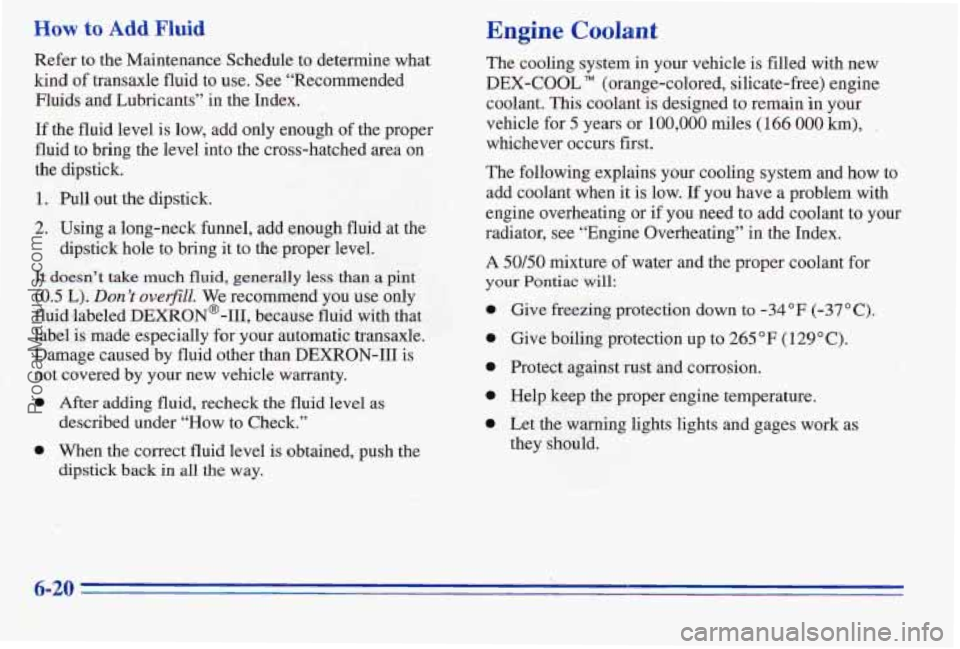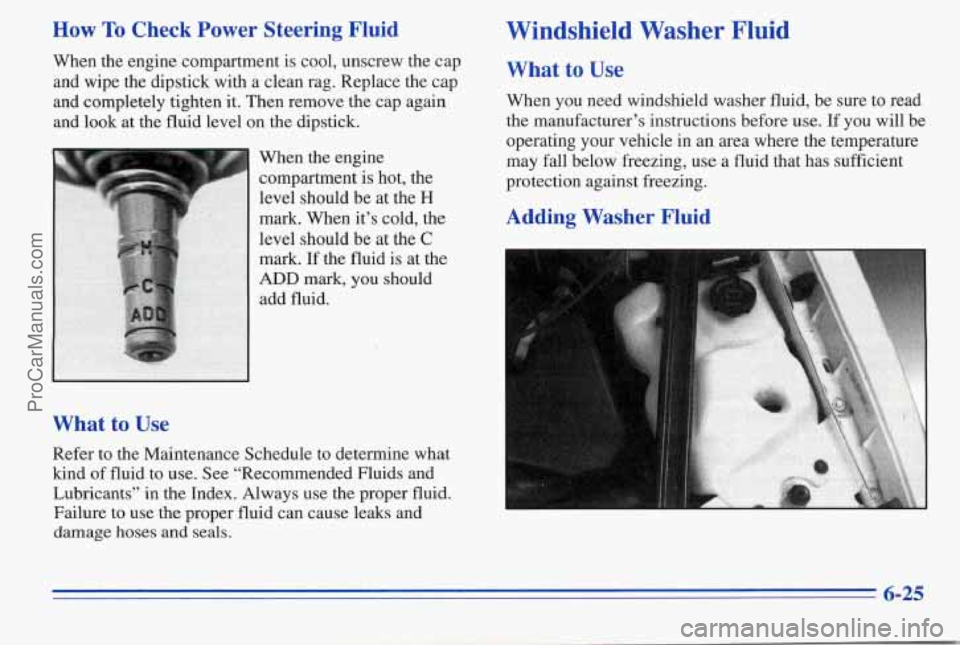Page 247 of 370

How to Add Fluid
Refer to the Maintenance Schedule to determine what
kind of transaxle fluid to use. See “Recommended
Fluids
and Lubricants” in the Index.
If the fluid level is low, add only enough of the proper
fluid to bring the level into the cross-hatched area on
the dipstick.
1. Pull out the dipstick.
2. Using a long-neck funnel, add enough fluid at the
It doesn’t take much fluid, generally less than a pint
(0.5 L). Don’t oveflll. We recommend you use only
fluid /labeled DEXRON@-HI, because fluid with that
label
is made especially for your automatic transaxle.
Damage caused by fluid other than
DEXRON-111 is
not covered by your new vehicle warranty.
0 After adding fluid, recheck the fluid level as
0 When the correct fluid level is obtained, push the
dipstick hole to bring
it to the
proper level.
described under “How to Check.”
dipstick
back in all the way.
Engine Coolant
The cooling system in your vehicle is filled with new
DEX-COOL (orange-colored, silicate-free) engine
coolant. This coolant is designed
to remain in your
vehicle for 5 years or 100,000 miles (166 000 km), ,
whichever occurs first.
The following explains your cooling system and how to
add coolant when it is low.
If you have a problem with
engine overheating or
if you need to add coolant to your
radiator, see “Engine Overheating” in the Index.
A 50/50 mixture of water and the proper coolant for
your Pontiac will:
0
0
0
0
0
Give freezing protection down to -34°F (-37°C).
Give boiling protection up to 265 “F (129°C).
Protect against rust
and corrosion.
Help keep the proper engine temperature.
Let the warning lights lights and gages work as
they should.
ProCarManuals.com
Page 249 of 370
NOTICE:
If yos we an improper coolant mix, your engine
could overheat and be badly damaged. The
repair cost wouldn’t be covered by your
warranty. Too much water in the
mix can freeze
and crack the engine, radiator, heater core and
other parts.
If you have to add coolant more than four times a year,
have your dealer check
your cooling system.
I NOTICE:
If you use the proper coolant, you don’t have to
add extra inhibitors or additives which claim to
improve the system. These can’ be harmful.
Checking Coolant
When your engine is cold, the coolant level should be at
the
COLD mqk or a little higher. When your engine is
warm, the level should be up to the HOT mark or a
little higher.
ProCarManuals.com
Page 251 of 370
Radiator Pressure Cap Power Steering Fluid
NOTICE:
Your radiator cap is a 15 psi (105 kPa)
pressure-type cap and must
be tightly installed to
prevent coolant loss and possible engine damage
from overheating.
Be sure the arrows on the cap
line up with the overflow.tube on the radiator
filler neck.
When you replace your radiator pressure cap, an AC@
cap is recommended.
Thermostat
Engine coolant temperature is controlled by a thermostat
in the engine coolant system. The thermostat stops the
flow
of coolant through the radiator until the coolant
reaches a preset temperature.
When you replace your thermostat,
an AC'thermostat
is recommended.
3.1L L82 Engine 3.4L LQ1 Engine
When to Check Power Steering Fluid
It is not necessary to regularly check power steering
fluid unless
you suspect there is a leak in the system or
you hear an unusual noise.
A fluid loss in this system
could indicate
a problem. Have the system inspected
and repaired.
6-24 -
ProCarManuals.com
Page 252 of 370

How To Check Power Steering Fluid
When the engine compartment is cool, unscrew the cap
and wipe the dipstick with a clean rag. Replace the cap
and completely tighten it. Then remove the cap again
and
look at the fluid level on the dipstick.
When the engine compartment is hot, the
level should be at the
H
mark. When it’s cold, the
level should be at the
C
mark. If the fluid is at the
ADD mark, you should
add fluid.
What to Use
Refer to the Maintenance Schedule to determine what
kind of fluid to use. See “Recommended Fluids and
Lubricants”
in the Index. Always use the proper fluid.
Failure to use the proper fluid can cause leaks and
damage hoses
and seals.
Windshield Washer Fluid
What to Use
When you need windshield washer fluid, be sure to read
the manufacturer’s instructions before use. If you will be
operating your vehicle in an area where the temperature
may fall below..freezing, use a fluid that has sufficient
protection against freezing.
Adding Washer Fluid
ProCarManuals.com
Page 291 of 370

Vehicle Identification Number (VIN)
ld
I I I1 11111111 1111 111 111111 111 1.
ENGINEA6 .) 1 ASSEMBLY
CODE MODEL YEAR PLANT
Tlus is the legal identifier for your Pontiac. It appears on
a plate in the front corner of the instrument panel, on the
driver’s side.
You can see it if you look through the
windshield from outside your vehicle. The VIN also
appears on the Vehicle Certification and Service Parts
labels and the certificates of title and registration.
Engine Identification
The eighth character in your VIN is the engine code.
This code will help you identify your engine,
specifications and replacement parts.
Service Parts Identification Label
You’ll find ths label on your spare tire cover. It’s very
helpful if
you ever need to order parts. On this label is:
your VIN,
the model designation,.
0 paint information, and
a list of all production options and special equipment.
Be sure that this label is not removed from the vehicle.
Electrical System
Add-on Electrical Equipment
NOTICE:
Don’t add anything electrical to your Pontiac
unless you check with your dealer first. Some
electrical equipment can damage your vehicle
and the damage wouldn’t
be covered by your
warranty. Some add-on electrical equipment
can keep other
components from working as
they should.
~~~~ ~~~~~
ProCarManuals.com
Page 310 of 370
I Short TriplCity Maintenance Schedule I
.6,000 Miles (10 000 km)
0 Change engine oil and filter (or every
3 months, whichever occurs first).
An Emission Control Sewice.
0 Lubricate steering ball joints (or every
6 months, whichever occurs first).
0 Rotate tires. See “Tire Inspection and
Rotation”
in the Index for proper rotation
pattern and additional information. During
tire rotation, check brake calipers for
freedom
of movement. Refer to the
appropriate
GM service manual for proper
caliper service procedures.
1
~
ACTUAL MILEAGE SERVICED BY:
9,000 Miles (15 000 km)
0 Change engine oil and filter (or every
3 months, whichever occurs first).
An Emission Control Service.
I DATE I ACTUAL MILEAGE [SERVICED BY: I
7-7
ProCarManuals.com
Page 312 of 370
I Short TripKity Maintenance Schedule I
18,000 Miles (30 000 km)
0 Change engine oil and filter (or every
3 months, whichever occurs first).
An Emission Control Sewice.
0 Lubricate steering ball joints (or every
6 months, whichever occurs first).
0 Rotate tires. See “Tire Inspection and
Rotation”
in the Index for proper rotation
pattern and additional information. During tire rotation, check brake calipers for
freedom of movement. Refer
to the
appropriate
GM service manual for proper
caliper service procedures.
DATE
SERVICED BY: ACTUAL MILEAGE
21,000 Miles (35 000 km)
0 Change engine oil and filter (or every
3 months, whichever occurs first).
An Emission Control Service.
DATE
SERVICED BY ACTUAL MILEAGE
7-9
ProCarManuals.com
Page 314 of 370
I Short Trip/City Maintenance Schedule I
30,000 Miles (50 000 km)
0 Change engine oil and filter (or every
3 months, whichever occurs first).
An Emission Control Service.
Lubricate ,steering ball joints (or every
6 months, whichever occurs first).
0 Replace air cleaner filter.
An Emission Control Service.
0 Inspect fuel tank, cap and lines for damage
or leaks. Inspect
fuel cap gasket for any
damage. Replace parts as needed.
An Emission Control Service.
0 Rotate tires. See “Tire Inspection and
Rotation” in the Index for proper rotation
pattern and additional information. During
tire rotation, check brake calipers for
freedom of movement. Refer
to the
appropriate
GM service manual for proper
caliper service procedures.
DATE SERVICED BY: ACTUAL MILEAGE
7-11
ProCarManuals.com